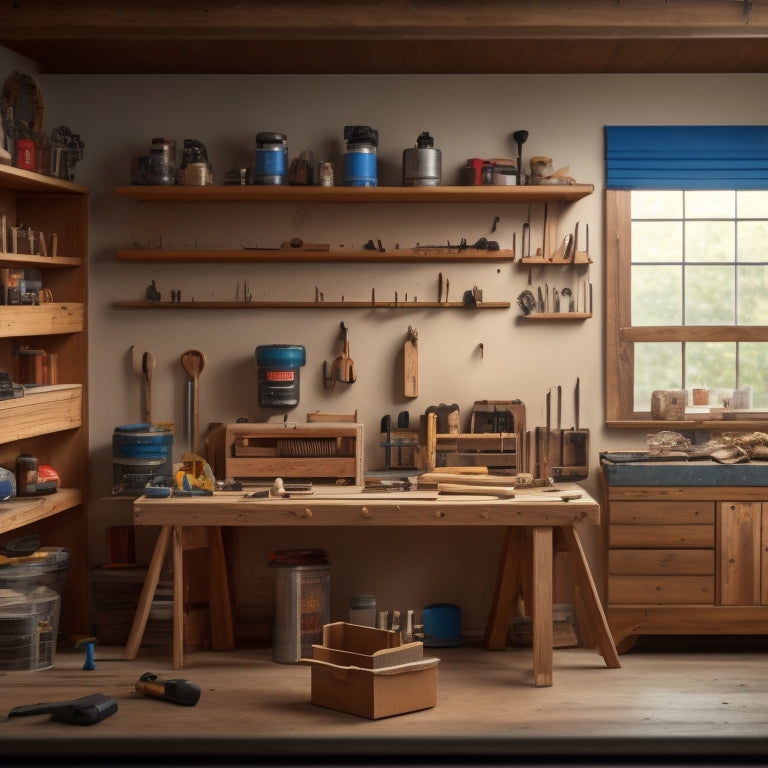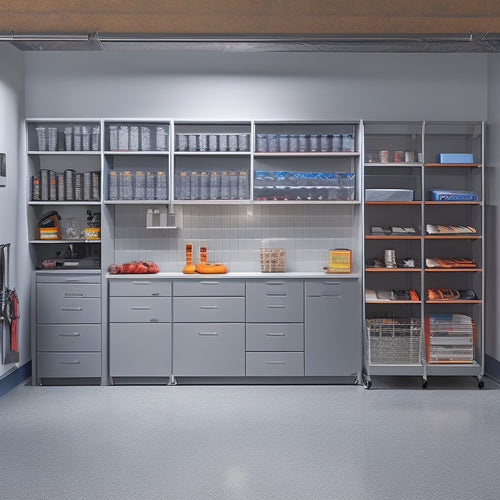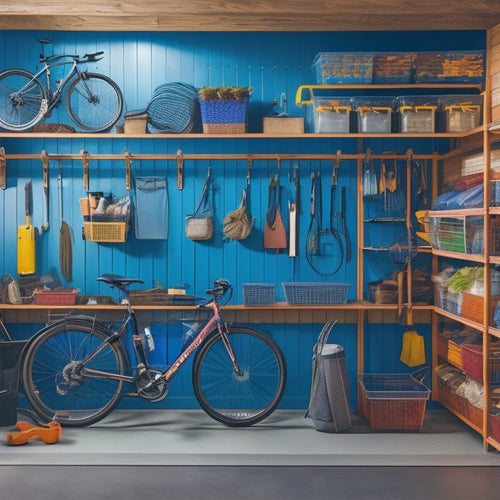
How to Build Your Own Shelving Unit in 5 Steps
Share
You'll create a custom shelving unit by planning your design, preparing materials, and assembling the frame. Next, add shelves and a back panel, ensuring secure attachments and proper alignment. Finally, finish and install the unit, sanding, staining or painting, and securing it to the floor. Throughout the process, prioritize tool safety and workspace organization. By following these 5 steps, you'll be well on your way to a functional and sturdy shelving unit that meets your needs; now, get ready to tackle the details that will bring your project to life.
Key Takeaways
- Define your shelving unit's purpose, weight capacity, material, and size to create a well-planned design.
- Gather high-quality materials and essential tools, ensuring a safe and organized workspace.
- Assemble the shelving frame with secure joints, adding support beams or diagonal bracing as needed.
- Add shelves and a back panel, ensuring secure attachment and alignment, and maintaining a safe working environment.
- Finish and install the unit, securing it to the floor and walls, and checking for level and plumb alignment.
Plan Your Shelving Unit Design
Determine the purpose of your shelving unit to define its design parameters. Are you looking to store heavy equipment, display decorative items, or organize office supplies? This will help you decide on the type of shelving unit style that suits your needs.
Consider the weight capacity, material, and size of your shelving unit.
Next, assess the space where the shelving unit will be installed. Measure the area to determine the maximum dimensions of your shelving unit. Take into account any obstacles, such as electrical outlets, windows, or doorways. Identify the type of flooring and verify your shelving unit is compatible with it.
When considering design parameters, think about the number of shelves, shelf spacing, and shelf material. Will you need adjustable shelves or fixed ones? What type of shelf supports will you use?
Answering these questions will help you create a safe and functional shelving unit that meets your specific needs. By carefully planning your design, you'll avoid costly mistakes and guarantee a successful build.
Prepare the Necessary Materials
With your design parameters in place, gather the materials needed to bring your shelving unit to life. You'll need lumber for the shelves and frame, screws, wood glue, and finishing nails.
When selecting wood, choose high-quality, straight-grained boards that match your design specifications. Confirm the wood is dry and free of knots or cracks to prevent structural weaknesses.
Next, gather your tools, including a tape measure, square, level, circular saw, drill press, and hand saw. Always follow tool safety guidelines to avoid accidents. Wear protective gear, such as safety glasses and a dust mask, when operating power tools.
Make certain your workspace is well-ventilated and clear of debris. Double-check your material list to confirm you have everything you need.
Don't forget sandpaper, wood filler, and a finish of your choice, such as stain or polyurethane. Having all the necessary materials on hand will save you time and frustration as you build your shelving unit.
Assemble the Shelving Frame
You're ready to start building the shelving frame, the foundation of your unit. Begin by laying out the vertical side panels on a flat surface, making certain they're aligned and evenly spaced according to your design plan.
Next, attach the horizontal top and bottom panels to the sides using wood screws, guaranteeing they're secure and the corners are square. For added frame stability, reinforce the joints with corner brackets or metal connectors.
Depending on your chosen shelving style, you may need to add additional support beams or diagonal bracing to prevent the frame from sagging or swaying. Consult your design plan or manufacturer's instructions for specific guidance.
As you assemble the frame, double-check your measurements and verify all components are properly aligned and securely fastened.
Remember to work in a well-ventilated area, wear protective gear, and use a level to make sure the frame remains plumb and level throughout the assembly process.
Add Shelves and Back Panel
Three shelves will be attached to the frame, spaced evenly apart according to your design plan. Measure and mark the shelf spacing on the frame's uprights, guaranteeing they're level and plumb. Cut the shelves to size using your chosen material, considering factors like weight capacity, durability, and aesthetics. For a sturdy build, opt for thick, high-density materials like 3/4-inch plywood or MDF.
Attach the shelves to the frame using screws or brackets, making certain they're secure and evenly spaced. Use a spirit level to double-check the shelves' alignment.
For added stability, consider adding a back panel to the unit. Cut the panel to fit the frame's back, and attach it using screws or nails. Confirm the panel is flush with the frame's edges to create a seamless look.
Throughout the process, prioritize safety by wearing protective gear, like gloves and safety glasses, and working in a well-ventilated area. By following these steps, you'll create a sturdy shelving unit that meets your design requirements.
Finish and Install the Unit
Finishing touches are essential to converting your shelving unit from a bare structure into a functional, visually appealing piece of furniture. To achieve a professional-looking shelf finish, sand the entire unit to smooth out any rough edges or splinters.
Apply a stain or paint that matches your desired color and style, following the manufacturer's instructions. Once dry, apply a clear coat of polyurethane to protect the finish.
Before installation, verify the floor is level and clear of any obstructions. Place the unit in its desired location, checking it's plumb and level.
Use wall anchors or screws to secure the unit to the wall, especially if you plan to store heavy items.
Installation tips: start by attaching the top of the unit to the wall, working your way down to the bottom. This prevents the unit from tipping over during installation.
Frequently Asked Questions
Can I Use Reclaimed Wood for My Shelving Unit?
You can definitely use reclaimed wood for your shelving unit, but first, verify you source it from a trusted supplier, considering benefits like unique character and reduced waste, while following wood sourcing tips to confirm stability and safety.
How Do I Protect My Shelves From Moisture Damage?
To shield your shelves from moisture damage, you'll need to apply moisture barriers to your shelf materials. First, coat the materials with a water-resistant sealant, then cover them with a breathable membrane to prevent moisture buildup.
Are There Any Weight Capacity Considerations for My Unit?
When building your shelving unit, you'll need to evaluate the weight capacity by selecting shelf materials that can support the intended load, and ensuring proper load distribution to avoid collapse, ensuring the safety of your stored items and people around.
Can I Add Doors or Cabinets to My Shelving Unit?
You can add doors or cabinets to your shelving unit by considering the shelf design and door styles that fit your needs, ensuring stability and weight capacity, and securely attaching them to the frame to prevent accidents.
Do I Need to Anchor My Shelving Unit to the Wall?
As you construct your shelving unit, don't let it become a ticking time bomb; anchor it to the wall, considering the type of wall materials you have, to guarantee stability and safety, following essential safety tips to avoid accidents.
Conclusion
As you step back to admire your handiwork, your newly built shelving unit stands tall, its sturdy frame and sleek shelves beckoning you to fill them with your favorite books, decorative trinkets, or treasured mementos. The satisfaction of creating something with your own hands is palpable, and you can't help but feel a sense of satisfaction and accomplishment. Your new shelving unit is more than just a piece of furniture - it's a reflection of your DIY spirit and creativity.
Related Posts
-

Heavy-Duty Pegboard Hooks for Industrial Use
You need heavy-duty pegboard hooks that can withstand the rigors of industrial use, providing a reliable and efficien...
-

Building a Garage Storage System With Built-Ins
You're about to build a garage storage system with built-ins that fits your unique needs, starting by evaluating your...
-

Garage Wall Storage Ideas to Boost Productivity
You can enhance your garage's productivity by capitalizing on your ceiling height with overhead racks, storing bulky ...


